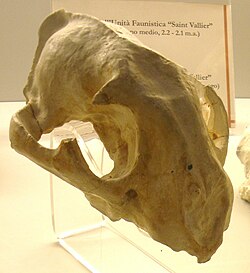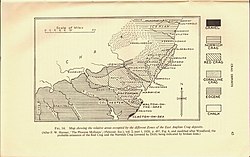| Red Crag Formation | |
|---|---|
| Stratigraphic range: Late Pliocene - Early Pleistocene ~ | |
 Red Crag at Bawdsey Cliff in Suffolk | |
| Type | Geological formation |
| Unit of | Crag Group |
| Sub-units | Sizewell Member |
| Underlies | Norwich Crag Formation |
| Overlies | Coralline Crag Formation or London Clay (unconformity) |
| Thickness | up to 20 metres (70 ft), locally up to 45 m, offshore up to 70 m |
| Lithology | |
| Primary | Sand |
| Location | |
| Region | Europe |
| Country | England |
The Red Crag Formation is a geological formation in England, deposited from the latest Pliocene to the earliest Pleistocene (Gelasian). [1] It outcrops in south-eastern Suffolk and north-eastern Essex. The name derives from its iron-stained reddish colour and crag which is an East Anglian word for shells. It is part of the Crag Group, a series of notably marine strata which belong to a period when Britain was connected to continental Europe by the Weald–Artois Anticline, and the area in which the Crag Group was deposited was a tidally dominated marine bay. [2] This bay would have been subjected to enlargement and contraction brought about by transgressions and regressions driven by the 40,000-year Milankovitch cycles.
Contents
The sediment in the outcrops mainly consists of coarse-grained and shelly sands that were deposited in sand waves (megaripples) that migrated parallel to the shore in a south-westward direction. [3] The most common fossils are bivalves and gastropods [4] that were often worn by the abrasive environment. [2] The most extensive exposure is found at Bawdsey Cliff, which is designated a Site of Special Scientific Interest (SSSI); [5] here a width of around 2 kilometres (1.2 miles) of Crag is exposed. At the coastline by Walton-on-the-Naze, remains of megalodon were found. [6]
The Red Crag Formation at depth in eastern Suffolk clearly has one member, the Sizewell Member, a coarse shelly sand with thin beds of clay and silt. [7] It was interpreted as having been deposited in large scale sand waves where the sea bed was deeper. The overlying Thorpeness Member, was provisionally assigned to the Red Crag based on its lithology but there is more evidence to suggest that it is part of the Norwich Crag Formation.
It has been proposed that the Red Crag started in the late Pliocene and to have possibly extended up into the early Pleistocene, but there is disagreement on more precise dating. According to the British Geological Survey, [8] the Red Crag sits within a segment of time from about 3.3 to 2.5 mya. It is considered that the Red Crag at Walton-on-the–Naze is the oldest and that it was deposited in only a few decades at some time between 2.9 and 2.6 mya. [9] This has led to the UK stratigraphic stage name Waltonian, which is usually correlated with the final Pliocene Reuverian Stage in the Netherlands. [10] While the precise age of the formation is uncertain, it is generally suggested that deposition of the formation as a whole spanned around 600-800,000 years. [1] There are difficulties in reconciling how the Red Crag equates with international chronological stages. In particular, the start and end dates are poorly defined due to the general paucity of age-diagnostic stratigraphic indicators and the fragmentary nature of the geology. It can also be difficult to separate the Red Crag from the overlying Norwich Crag Formation.
The base of the formation contains a nodule-rich bed (termed the "Nodule Bed", or "Coprolite Bed") with fossils including terrestrial vertebrates (as well as marine fossils such as those of whales and shark teeth), some of which were reworked from deposits considerably older than the Red Crag Formation itself and often display abrasion and polish indicating reworking. [11] While some of these animals are as old as the Eocene (such as Hyracotherium and Coryphodon , originating from the London Clay), [12] most originate from the Pliocene and late Miocene, at least as early as MN 11-12, around 9-7 million years ago in the case of some species. [11] The presence of monkeys and other thermophilic species implies that during the late Miocene-early Pliocene, the region was probably considerably warmer than today, and had a subtropical climate. [11] During the Late Pliocene, the region is thought to have had a temperate climate. [13] The Red Crag also contains Early Pleistocene fossils of animals similar in age to the formation itself, though terrestrial vertebrate fossils from the rest of the Red Crag are considerably rarer than those from the nodule bed. [12] The phosphatic nodules and bones in the bed were historically during the mid-late 19th century ground up on industrial scales to use as fertilizer. [14]






































